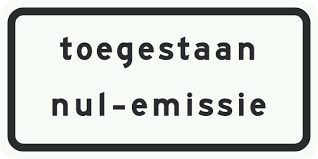From 1 January 2025, several Dutch cities will introduce Zero Emission Zones (ZE zones) to reduce harmful emissions and improve air quality. These zones are aimed at vans and trucks, which must then be emission-free in these areas.



What is a ZE zone and how does it differ from environmental zones?
ZE zones are defined areas in which only zero-emission vehicles are permitted. This concerns all vans and trucks intended for the transport of goods. Known to the RDW under vehicle categories N1, N2 and N3. Vehicles in a ZE zone may therefore not have any harmful emissions at all, unlike environmental zones where only certain polluting vehicles are restricted or prohibited.
ZE zones are introduced to improve air quality, protect the health of residents and contribute to climate objectives by reducing the emission of CO₂ and other harmful substances.
General information about the new measure
If you have to be in one of the city centres with your company car, which runs on diesel or petrol, from 1 January 2025, a number of things may have changed. 33 municipalities have conducted research into, or have now decided to introduce, ZE zones. The effective date of the zero-emission zone varies per municipality.
Which cities are introducing a ZE zone from 2025?
Cities such as Groningen, Maastricht, Nijmegen and Leiden, among others, have plans to introduce ZE zones from 2025. A total of 33 municipalities have indicated that they will implement this measure or are investigating it.
Access to ZE zones is only permitted for vehicles that are completely emission-free, such as electric or hydrogen-powered vehicles. Restrictions apply to other vehicles and fines may be imposed for violations.
Transitional arrangement and subsidy
A transitional arrangement applies until 2030 for certain vehicles, such as diesel vehicles with a Euro 6 standard that were registered before a certain date. These vehicles can temporarily access the ZE zones under specific conditions.
Exemptions and waivers are available for vehicles that perform a special function, such as emergency services, or for vehicles that are not yet emission-free but are essential for certain economic activities. Applications for exemptions can be submitted via the RDW.
The government offers subsidies for the purchase of new zero-emission vans and trucks. These subsidies are intended to financially support entrepreneurs in the transition to a zero-emission fleet and can significantly help cover the purchase costs of these vehicles. More information about this can be found on the website of the RVO.


This positive development also brings certain challenges. For example, in addition to the implementation of the ZE-Zones, we must also consider the enforcement of the measures. Brickyard has currently started preparing for the arrival of the ZE-zones with various municipalities, such as those mentioned above, by implementing a camera enforcement system. In the process towards Zero Emission City Logistics, Brickyard is also in close contact with national independent consultancy firms and involved companies, such as the SHPV and the RDW, who also deal with the same theme.
We have been specialists in the field of digital enforcement of closed declarations, pedestrian areas and environmental zones in various forms for years, by means of camera enforcement and scan cars. In this way, together with enforcement organisations, we ensure a better quality of life in many cities in the Netherlands.
Want to know more about how Brickyard can help with the introduction of the ZE-zones? Send us an e-mail via info@brickyard.eu or contact our account managers.
